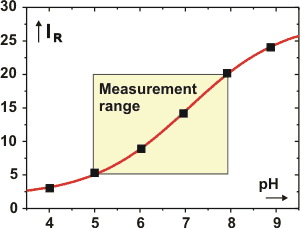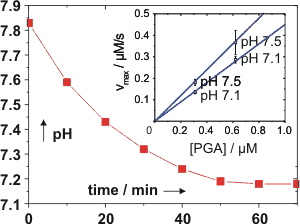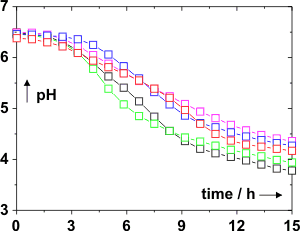Description
- Measurement of pH in microplates
- Enzyme Screening
- Monitoring of Cell Proliferation
- Starter Cultures
- Homogenous Assay
- Fast results
The HydroPlate® is a sterile polystyrene microplate in the common 96 well format with 96 integrated sensors. A sensor is immobilized on the bottom of each well. This sensor can be read out from the bottom side. This can be done be a commercially available fluorescence plate reader.
PreSens offers two different types of Hydroplates; HydroPlate® HP96U (96 well round bottom MTP for cell culture) and HydroPlate HP96C (96 well flat bottom MTP for cell culture). |
Features
- Calibration-FREE - The HydroPlate® is calibration-FREE. It contains 2 different dyes. This combination ensures its unique internal referenced signal to achieve the most exact results of your experiments.
- Cost saving - HydroPlate is read out from the bottom side by any commercial available fluorescence reader which is able to work in dual wavelength mode.
- Sterile - All HydroPlates are dilivered sterile (gamma-Sterilisation)
- Homogenous - No additional reagents required.
- Easy to use - PreSens delivers software for evaluation on request.
- Individual - PreSens offers different types of HydroPlates.
see the Hydroplate® Short info |
Specifications
HydroPlate® HP96L / HP96C
96 well flat / round bottom microplates |
| Response time (t90) |
< 30 sec |
| Measurement range |
pH 5.0 – 8.0 |
| Resolution(at 37°C) |
up to 0.01 pH* |
| Accuracy (at 37°C) |
up to 0.05 pH* |
| pH drift per hour* |
< 0.02 pH / h* |
| Temperature Range |
from 15 to 45 °C |
| Indicator filters |
485 / 538 nm |
| Reference filters |
485 / 620 nm |
|
* performance dependent on used reader
|
|
 |
Detailed specification can be found in Hydroplate® User's Manual. |
Applications
 |
Screening the Enzyme reactions
HydroPlate® monitors enzymatically catalyzed reactions. The large figure (left) shows the measured pH-change of one experiment during hydrolysis of an ester catalyzed by Penicillin-G-acylase (PGA). From these pH-changes the enzymatic activity can be calculated. The small graph shows the linear dependency of enzyme concentration and activity measured with HydroPlate®. Also different starting pHs can be compared using HydroPlate®.
|
|
Screening the proliferation of cells
HydroPlate® measures pH changes due to the growth and metabolic activity of cells. The picture depicted on the right hand side shows the growth of different concentrations of E. coli.
Each dilution was ten-fold lower concentrated. The beginning of the pH decrease could be stated in a period of 1.25 h between each measurement.
|
|
 |
Screening Dairy Starter Cultures
HydroPlate® HP96L measures changes after adding Lc. Lactis to milk samples. Even in this self-fluorescent and light scattering media HydroPlate® HP96L measures pH changes accurately.
From the comparison to measurements with pH-electrodes it is concluded that HydroPlate® HP96L can be used reliably to characterize particularly a large number of strains for screening purposes but also for quality control.
|
|
Calibration
HydroPlate® does not need to be calibrated. However, the absolute light intensity of the used fluorescence reader is not known, so that this has to be determined by a multi-point calibration of the reader. This is explained in the manual and performed using standard buffer solutions.
Hydroplate® spectra
HydroPlate® manual (HP96U & HP96C)
|
Measurement
The measurement is performed by using the software of your fluorescence reader. From the measured signal the pH can be calculted.
|
Download
|
| |
|
|
|


